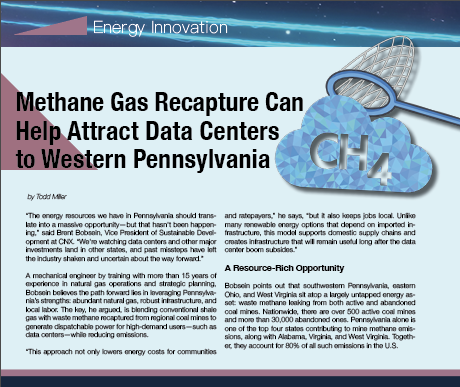Methane Gas Recapture Can Help Attract Data Centers to Western Pennsylvania
By Todd Miller
 “The energy resources we have in Pennsylvania should translate into a massive opportunity—but that hasn’t been happening,” said Brent Bobsein, Vice President of Sustainable Development at CNX. “We’re watching data centers and other major investments land in other states, and past missteps have left the industry shaken and uncertain about the way forward.
“The energy resources we have in Pennsylvania should translate into a massive opportunity—but that hasn’t been happening,” said Brent Bobsein, Vice President of Sustainable Development at CNX. “We’re watching data centers and other major investments land in other states, and past missteps have left the industry shaken and uncertain about the way forward.
A mechanical engineer by training with more than 15 years of experience in natural gas operations and strategic planning, Bobsein believes the path forward lies in leveraging Pennsylvania’s strengths: abundant natural gas, robust infrastructure, and local labor. The key, he argued, is blending conventional shale gas with waste methane recaptured from regional coal mines to generate dispatchable power for high-demand users—such as data centers—while reducing emissions.
“This approach not only lowers energy costs for communities and ratepayers,” he says, “but it also keeps jobs local. Unlike many renewable energy options that depend on imported infrastructure, this model supports domestic supply chains and creates infrastructure that will remain useful long after the data center boom subsides.”
A Resource-Rich Opportunity
Bobsein points out that southwestern Pennsylvania, eastern Ohio, and West Virginia sit atop a largely untapped energy asset: waste methane leaking from both active and abandoned coal mines. Nationwide, there are over 500 active coal mines and more than 30,000 abandoned ones. Pennsylvania alone is one of the top four states contributing to mine methane emissions, along with Alabama, Virginia, and West Virginia. Together, they account for 80% of all such emissions in the U.S.
Today, less than 1% of mine methane is captured. Instead, it’s typically released into the atmosphere—contributing significantly to greenhouse gas emissions. Methane accounts for roughly one-third of Pennsylvania’s total greenhouse gas output.
“If we do nothing, it gets worse,” Bobsein warned. “Abandoned mines continue venting methane for decades after closure.”
Yet the potential environmental and economic benefits of addressing this issue are enormous. CNX estimates that Pennsylvania alone vents around 160 billion cubic feet of methane annually—gas that could otherwise be captured, cleaned, and converted into usable energy.
Reclaiming Wasted Energy
 Despite being the second-largest producer of natural gas in the country, Pennsylvania uses only about 25% of the gas it produces; the remainder is exported, primarily to neighboring states like Virginia. This “bottlenecked supply,” as Bobsein called it, reflects an untapped opportunity to use more of Pennsylvania’s own energy to drive economic growth at home.
Despite being the second-largest producer of natural gas in the country, Pennsylvania uses only about 25% of the gas it produces; the remainder is exported, primarily to neighboring states like Virginia. This “bottlenecked supply,” as Bobsein called it, reflects an untapped opportunity to use more of Pennsylvania’s own energy to drive economic growth at home.
CNX is already acting on this opportunity. The company operates one of only three systems in the country capable of turning remediated mine gas (RMG) into energy on a commercial scale.
“We’re committed to doing this the right way — engaging local communities, working with organized labor, and aligning with policymakers and energy users,” says Bobsein. “We want to bring everyone to the table and ensure that frontline communities benefit, not bear the burden.”
According to Bobsein, methane remediation offers a more cost-effective route to net-zero energy than many traditional renewable options. “In just two years, we can stand up a plant capable of generating 8 gigawatt-hours of electricity per year with net-zero emissions. That’s enough to power 2.5 million homes.”
A Strategic Advantage for Pennsylvania
To make the most of this potential, Bobsein believes the Commonwealth must create clearer pathways for companies looking to locate data centers in-state. That includes streamlining permitting for facilities that use captured methane and helping to offset regulatory costs that can make natural gas projects appear more expensive upfront—despite their long-term economic and environmental benefits.
“In Pennsylvania,” Bobsein concluded, “we can deliver scalable, net-zero energy solutions that few other states can match. The pieces are all here—we just need to bring them together.”
Turning Waste Into Energy
by Todd Miller
 Efforts are under way to convert waste into a valuable energy resource through technologies such as anaerobic digestion and pyrolysis, offering Western Pennsylvania a cleaner, more scalable path to renewable energy if public support and strategic partnerships align.
Efforts are under way to convert waste into a valuable energy resource through technologies such as anaerobic digestion and pyrolysis, offering Western Pennsylvania a cleaner, more scalable path to renewable energy if public support and strategic partnerships align.
Web3Rivers founder Jose Amayo, an entrepreneur and lifelong Pittsburgher, is developing an anaerobic digestion process that utilizes sealed containers and specialized microorganisms to break down biodegradable materials such as agricultural and municipal waste. As these materials break down, they generate methane, a greenhouse gas that is 86 times more potent than carbon dioxide in the short term.
“Highly combustible, methane can be captured and used as a powerful fuel source,” said Amayo.
Web3Rivers is also exploring pyrolysis, an innovative process that separates hydrogen, carbon, and oxygen from methane without releasing carbon dioxide. Although more expensive, pyrolysis is cleaner and produces valuable byproducts, like “green” hydrogen for hydrogen fuel cells.
Amayo’s team is piloting anaerobic digestion in Kentucky using bourbon industry waste, with plans for a similar effort in Pittsburgh. But Pittsburgh’s urban waste streams present logistical challenges. One promising source is human waste from sewage treatment.
Dr. John Stolz, PhD, Director of Environmental and Energy Engineering at Duquesne University, is working with state and local officials to build awareness and attract partners to support this initiative. While wastewater treatment facilities like ALCOSAN, currently undergoing a multibillion-dollar upgrade, have been exemplary in developing odor-reducing technology, they have been hesitant to adopt new technologies for energy generation.
Pennsylvania currently hosts six municipal waste-to-energy plants, all in the eastern and central parts of the state. Demonstrating the viability of anaerobic digestion in Western Pennsylvania could take months, with full implementation years away. Still, Amayo is optimistic. “Early-stage projects could begin producing usable electricity within six to nine months.” Academic labs like those at Duquesne are testing key variables like bacterial quality to guide deployment.
Although waste management firms already capture methane from landfills, anaerobic digestion and pyrolysis offer more control over emissions and output.
“One of the biggest misunderstandings is around energy economics,” said Amayo. “People assume more usage equals higher cost, but the opposite is true when you have the right technology. Demand enables scale.”
He added, “Western Pennsylvania has the scientific and industrial talent to lead in clean energy. What we need now is the political will and public understanding.”
With the appropriate support, these technologies could transform the region’s waste into a catalyst for sustainable energy leadership.